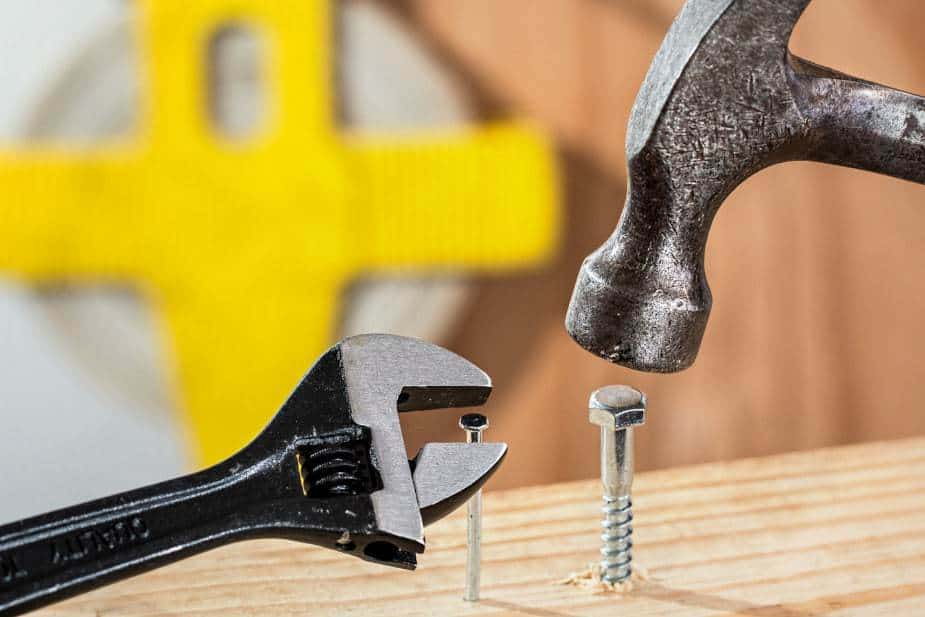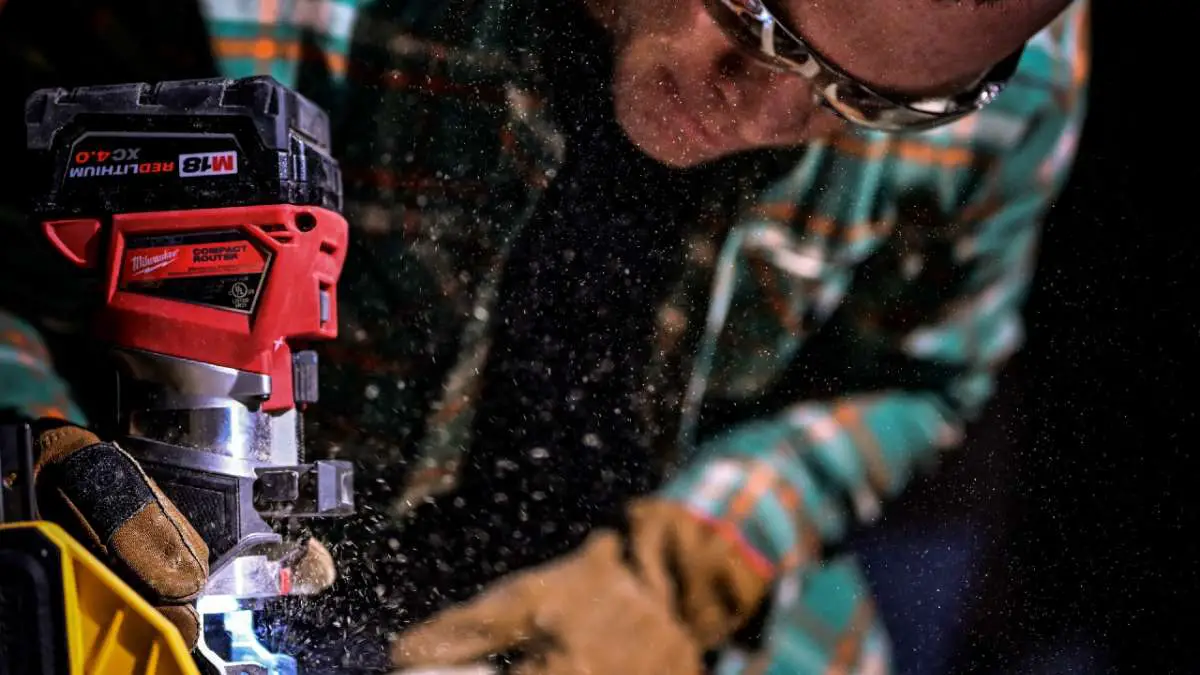The Jigsaw vs Router: Which one is better? Can you cut wood with these woodworking power tools? This post is about power tools for the beginner. It focuses on a comparison of the Jigsaw vs Router. Does one tool have advantages over the other? The post will list pros and cons in order to help you choose the right tool.
Note: This post may contain affiliate links. If you purchase a product through an affiliate link, I’ll earn a commission, at no cost to you. To find out more, see my full disclosure.
1. Jigsaw vs Router: Can Make a Deeper Cut With a Jigsaw
Jigsaw blades vary in size. However, they are usually much longer than router bits. So they can cut further into the wood. As a result, thicker wood can be cut with the jigsaw.
However, you must also consider the power of the tool. Even if the jigsaw blade is long enough to cut through the stock, the jigsaw motor might not supply enough power for this operation.
Also, a router might not have enough power for this. However, you could make the cut in several passes. During the first pass, you could put the bit down part of the way. Then, you could increase the depth on each successive pass until you cut through the wood.
2. Jigsaw vs Router: The Router Is Not Really a Saw

Let’s say you had to make a simple cut through wood. Would you use a jigsaw or a router?
Usually, saws cut the wood into two pieces. However, jigsaws also allow you to cut out curves in the wood.
Instead of a blade, the router uses a rotating bit. The sharp edges of the bit allow you to cut slots and grooves into the wood. In addition, you can round edges and cut shapes.
If you can lower the router bit so that it extends below the depth of the wood you can actually cut it into two pieces. However, this process is a lot of work. For simple cuts, it’s far easier to use the jigsaw.
3. Jigsaw vs Router: Jigsaw Cuts Are Easier To Set Up
With a jigsaw, you just draw a line on the wood and follow it. However, you still might need to clamp some sort of a guide piece onto the wood in order to ensure that you’re cutting an entirely straight line. Also, most jigsaws include a rip attachment. It guides the jigsaw. However, this is not always accurate. In summary, you don’t need guides for all jigsaw cuts. Even if you do need one, it’s not a big deal it doesn’t take much time to set up.
However, guides are more of an issue with the router. The router uses a rotating bit to cut the wood. It rotates at extremely high speed: some bits spin at 24,000 rpm! Since the bit cuts in any direction, it’s easy to move off the line. So, you often need to set up a guide or jig for the cut.
Clamp the wood securely. You need to go through several passes as the bit depth is increased. If the wood moves, the cut will not be accurate.
4. The Router is More Dangerous Than The Jigsaw
First, let me say one thing: All power tools are dangerous. You always need to maintain control over all power tools and follow proper safety rules.
However, you can consider some tools to be more dangerous than others. For more information, please see my article about dangerous woodworking tools. I feel that the router is a very dangerous tool. This is because the bit moves at such a high speed. In the section above, I mentioned that it could spin at 24,000 revolutions per minute! A very powerful motor turns the router bit. This motor can be 3 horsepower or more. Imagine the damage that can be done if you lose control of the router!
In addition, the router generates plenty of sawdust and is extremely loud. So, you need eye and ear protection. If you cut off too much wood at once, it can split and shoot out. You may need several cutting passes.

5. Jigsaw Blades Are Easier To Change Than Router Bits
When a jigsaw blade breaks, you need to change it for a new one. Different steps in your project may call for different blades. So, if it’s difficult to change blades, your project can take more time.
With many jigsaws, you only need to turn an Allen screw to change the blade. As long as you have the proper tools, this process doesn’t take much time and is easy. In addition, you don’t need to adjust bit depth.
However, with the router, you first need to lock the bit from rotating. You then need to use a wrench to loosen the bit collet. Then, you remove the bit and replace it with a new one. After that, you tighten the collet with the wrench and remove the lock. After all of that, you need to restore the bit depth so that everything is as it was before the change.
This is not the end of the story. Fast chucks are available for routers. You only need to turn an Allen screw to loosen the bit. While this does save time, there is still a hassle since you need to worry about the depth adjustment. In summary, router bits are not as easy to change as jigsaw bits.
6. Jigsaw vs Router: The Jigsaw Can Make a Rougher Cut
When a cut is rough, you need to add a sanding step. This is because you probably want to apply stain or some other wood finishing. If that is the case, all marks need to be removed from the wood. I have written an article about sanding wood.
As the jigsaw blade moves up and down, it can tear up the wood. This is more of an issue with plywood. The blade can break up this material. You might not be able to repair this damage by sanding the wood.
You can make a smoother cut with a finer toothed blade. That is, a blade having more teeth per inch. Also, many jigsaws have a variable speed feature. Some woods require a slower speed while others need a faster speed for a good cut.
However, the rotating router blade makes a clean, smooth cut through the wood. You may need to make several passes and only take off a small amount of wood at a time. However, you can get much better results.
7. The Router Bit Can Char Wood
This is more of a problem with some woods than with others. If these marks occur, they need to be removed by sanding. This is inconvenient and takes time.

So, what causes this in the first place? As you know, friction causes heating. If the router bit is dull, it will rub against the wood and heat it up. Wood oils can contribute to this issue.
There are some other factors: If the router bit rotation speed is higher, there can be more rubbing and more char marks. Also, you can reduce char marks by increasing the speed of your pass through the wood. However, you need to make sure that you don’t attempt to remove too much wood in a single pass.
The jigsaw blade moves at a much slower speed and you don’t seem to have this problem. Follow the blade manufacturer recommendations: Use the right blade for the type of wood you’re cutting, and set the machine to the proper blade speed.
8. Jigsaw vs Router: The Router Can Make Sharper Turns
By moving the jigsaw along a curved line, you can cut curves into the wood. In fact, some jigsaws have a scrolling knob. This allows you to rotate the blade in order to cut tighter curves. However, if the curve is too sharp, you will break the blade.
The router has a round bit, not a flat blade like the jigsaw. because of this, it can cut in any direction. You can travel in one direction, and then move 90 degrees from that direction. You do not need to follow a gradual curve. So, the router bit will not break if the curve is too sharp.
9. The Router Allows Cuts You Cannot Make with a Jigsaw
A jigsaw let you cut the wood into two pieces. Also, you can cut curves in the wood. Does a router let you make more types of cuts? YES, it does! Here are some of the cuts that can be made with a router:
- Rabbet – This is a square notch through the wood. You can control the width of the notch with guides. Also, you can make Dado joints for projects such as bookcases.
- Chamfer – This is a slanted or beveled line through the wood. The jigsaw also allows you to make a bevel cut by tilting the base plate. However, the router cut is neater, smoother and more accurate.
- Rounded – This is a round cut for a wood edge. While you can round wood with sandpaper, the router is faster and makes a more accurate cut.
- Dovetail – This makes cuts through the wood and is used to join pieces together. For example, drawers commonly have dovetail joints. Usually, a specialized jig is used in combination with the router to make dovetail joints.
10. Routers Can Use Piloted Bits
What are piloted bits? These bits have a round bead or bearing at the bottom and/or top. In addition, some pilot bits have no rotating bearing. Instead, they have a smooth surface that rotates along with the bit. The bearing or surface moves along the edge of the wood and guides the bit as it cuts into the wood.
This is a nice arrangement, however, the accuracy of the cut depends upon the accuracy of the wood edge. Is it entirely “square”? Or, does it “bow outward” in a curve? If the edge is “off”, the routed cut will be “off”.
Also, the round pilot bearings can leave marks on the wood. These need to be sanded out before wood finishing, If this is not done, the stain will make the marks visible.
How do the piloted bits leave marks? Well, the bearings get pushed into the wood as you guide the router. Some people prefer to take the extra time and set up a guide so that the pilot bearings are not even needed. Then, they use bits without pilot bearings. In this way, they avoid marks caused by the piloted bits.
11. Jigsaws Are Not Suited For Cross Cuts
The two main cuts you are concerned with in woodworking are rip cuts and cross cuts. Rip cuts are made along the grain of the wood while crosscuts are across the grain. Using a Try Square, you can draw a line across the grain of the wood. You can follow that line with a jigsaw. However, the cut won’t be clean. Usually, it’s too rough and the edge isn’t smooth.
However, the router can make a smoother and more accurate cut in the wood. This requires a guide. Also, you will probably need several passes through the wood to actually cut through it.
In addition, you need to make sure that the router bit can be lowered to the depth of the wood. This entire process is time-consuming and will take several passes as deeper and deeper cuts are made. If you try to remove too much in one pass, you might crack the wood or get char marks on it.
12. Jigsaw Blades Make Thin Cuts
Jigsaw blades are usually thin and flat. As a result, the blade does not remove too much “extra wood” when it makes the cut. This “extra” is known as the blade “kerf”. You need to account for this distance, or the sizes in your project will be “off”. So, the pieces will not fit together properly.
Router bits vary in size. However, the typical diameter is much larger than the thickness of a jigsaw blade. As a result, much more material is removed and the “kerf” is much larger. This results in much more wasted wood.
The round, rotating bit of a router allows it to move in any direction.
The jigsaw is a safer tool because the teeth are only on one side of the blade, in the front. This is the only side that cuts. However, the round router blade cuts on all sides. The sharp edges cover more of an area.
13. Can Adjust The Jigsaw Base For a Bevel Cut
As we mentioned before, a bevel is a slanted cut through the wood. Most jigsaws allow you to adjust the base so that the blade makes a bevel in the wood. This process is quick and simple.
You can do the same thing with a router. However, you need to use a special bit for that purpose. So, you may need to change bits for this. Also, the bit may not be the right size for your needs. That is, you may need a longer bevel than is possible with the bit.
The router cut is usually neater and cleaner. Nevertheless, the jigsaw is much easier to use.
For more information, see another article I wrote called: What is a Jigsaw?
14. Use Fewer Passes With Jigsaw
With the jigsaw, you only need to cut through the wood once. The blade extends through the entire depth of the wood and it’s cut into two pieces.
With the router, you may only be able to remove a small bit of wood at one time. You will need to make several passes and increase the cut depth each time. This is more time-consuming. Also, guides are required to make sure that the cut is accurate. You must make sure that the router is held in the same place throughout all the passes.
Another factor is the strength of the motor. Even though the jigsaw blade is long enough to cut through the wood, the motor power might not be sufficient for a clean cut.
15. Jigsaw vs Router: The Jigsaw Is Less Expensive
Jigsaws are usually less expensive than routers. Let’s say you don’t have enough money for both a jigsaw and a router. Which one should you get first? The answer is really unclear. It depends on the things you need to do, what other tools you have, and many other factors.
Actually, the cost of jigsaws and routers can depend on the particular features they have such as variable speed, orbital motion (for the Jigsaw), and motor power. In addition, you need to consider the cost of tool accessories, guides, and blades (for the jigsaw) or bits (for the router).
Here’s a low-cost Jigsaw as well as a budget router:
PORTER-CABLE 20V MAX Jig Saw, PCC650B
This is a great jigsaw for beginners. It’s not very expensive. This leaves you money to add even more tools to your workshop! However, it’s a high-quality tool that enables you to perform a variety of woodworking tasks.
The Jigsaw has a variable speed motor. This gives you more control over your cuts and makes them cleaner.
It also uses T-Shank blades and a tool-free blade release. So, you don’t need to locate an Allen wrench to change the blade! This is much easier, and also faster.
This tool has a Dust Blower to keep the blade area clean as the tool cuts through wood.
Makita RT0701C 1-1/4 HP Compact Router
This popular router will do the job, yet not cost you an arm and a leg!
It has many features, including the following:
- Electronic Speed Control – Maintains a constant speed as the load varies.
- Rack and Pinion Depth Adjustment – This system allows you to have fine control over the actual depth of bit.
- Quick-release Cam Lock System – Allows you to lock depth settings with ease.
- Heavy-Duty Aluminum Housing – This adds to the durability and strength of the tool.
- Optional Dust Collection System – The base can accept an optional dust collection port. This is important since routers generate considerable sawdust. You don’t want wooden debris to obscure your view of the cutting area.
I have gone through 15 pros and cons for the jigsaw vs router. Hopefully, this will help you pick the right tool for your needs.
Don’t forget to follow my boards on Pinterest. If you enjoyed this post, please share.


